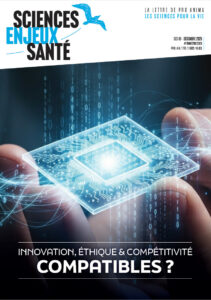
News on non-animal methods
OCTOBER 27 - 31, 2025
NEWS, REPORTS & POSITION STATEMENTS
1. NAMs for drug-induced liver injury (DILI): Where are we now?
The U.S. FDA’s National Center for Toxicological Research (NCTR) has published a new review: “New approach methodologies (NAMs) for drug-induced liver injury (DILI): Where are we now?”. The authors performed comparative analyses of in vitro NAMs with animal models (the conventional approach) and MPS (the most complex NAM to date), as well as comparisons among in vitro NAMs themselves.
The study shows that Multiparametric NAMs might simulate animal models better than single-parametric methods, suggesting that DILI could be better addressed with multi-parametric approaches such as cell painting or by combining mechanistically specific NAMs to capture the complexity of DILI mechanisms. Pairwise comparisons among six in vitro NAMs revealed substantial variability in the overlap of tested drugs (often fewer than 50 drugs), impacting the statistical robustness of the results. This variability highlights the critical need for a standardized drug list to facilitate cross-NAM evaluations and ensure consistent and reliable comparisons.
2. OOC technology used at the University of Bradford for the first time
Dr Ethan Perkins, a lecturer in Cancer Biology and Therapeutics, has secured a £24,900 grant from Animal Free Research UK to develop a fully humanised organ-on-a-chip (OOC) model of prostate cancer. The 12-month project will simulate how cancer drugs interact with human tissues, without using animals or animal-derived materials.
“It’s not just about replacing animals — it’s about building better, human-relevant systems,” said Dr Perkins. “This is a step forward in making drug testing more ethical, accurate, and effective.”
INTERVIEWS, NOMINATIONS & AWARDS
3. HUMAIN Award winners
The Physicians Committee for Responsible Medicine (PCRM), a nonprofit that advances human-based science, and InSphero, a global leader in 3D in vitro technology for drug safety and efficacy testing, announced the winners of the 2025 Human Advanced In Vitro Model Initiative (HUMAIN) Award. The HUMAIN Award recognizes researchers working to expand access to and accelerate the uptake of human-specific nonanimal approaches. By supporting these projects, the award helps reduce reliance on animal experiments and accelerates the shift to more predictive, ethical research methods.
Five outstanding teams from Spain, the U.S., Switzerland, Portugal, and Germany are using 3D human cell models to transform toxicology, reproductive health, cancer therapy, osteoarthritis, and diabetes research.
4. Students from Karolinska Institute became EURL ECVAM student ambassadors
In 2024, the EU Reference Laboratory for Alternatives to Animal Testing (EURL ECVAM) launched a Student Ambassador Project, which aims to disseminate knowledge and raise awareness of non-animal methods among students, and to build a network of ambassadors who can share knowledge and inspire their peers.
Students from the Master’s Programme in Toxicology at Karolinska Institutet have been involved in the project from start.The 3Rs Swedish Center have spoken to three toxicology students Erofili Bougka, Katia El Nemer, and Paulina Diana Sawicka to hear about their experience as ambassadors and to learn more about the project. “The Ambassador Project is a great opportunity to inspire early-career scientists and build a collaborative network where researchers can exchange ideas and promote the adoption of non-animal methods”, says Erofili.
TOOLS, PLATFORMS, CALLS
5. STEP4NAMS Call opening — Join the Future of NAMs
The STEP4NAMS project opens its call for organisations and companies to participate in their cutting-edge pilot studies. These real-world pilots are validating NAMs to replace animal testing in the (Bio)Pharma and MedTech sectors.
The four pilot topics and leading institutions:
- Lung-on-Chip & Digital Twin Systems (University of Galway)
- Multi-site Validation of Organ-on-Chip Models (3R-Center Tübingen)
- Bench-top Stroke Device Simulations (Atlantic Technological University)
- Parkinson’s Disease Organoids (Université du Luxembourg)
6. SETAC Europe Abstract submission is open
Society of Environmental Toxicology and Chemistry (SETAC) Europe 36th Annual Meeting is coming up in May 2026, and the abstract call is now open (Deadline: 26th November).
If you are working on NAMs, molecular tools, or One Health frameworks and interested in bridging the gap between cutting-edge science and regulatory acceptance:
- Submit your abstract to Session 1.11- From Innovation to Regulation: Next Generation Environmental Risk Assessment with Molecular Approaches, NAMs, and One Health Perspectives
- Submit your abstract to Session 7.12 — Integrating in Silico (Q)SAR Methods Into Regulatory Framework: Issues, Challenges and Opportunities
Read more and discover all the Sessions
7. The JRC looking for experts in cardiovascular research and call for evidence
The Joint Research Center (JRC) just announced a new initiative aimed at advancing NAMs in cardiovascular research, a critical health concern. This initiative aligns with the European Cardiovascular Health Plan, aiming to enhance research outcomes while reducing reliance on animal testing. Key objectives are: assist researchers in finding and using NAMs in research, focusing on innovative in silico, in vitro, and ex vivo techniques, improve human relevance and health outcomes of cardiovascular research, reduce the number of animals used and their suffering in the field of cardiovascular research.
- The JRC is looking for experts in cardiovascular research to join the sub-group of the EURL ECVAM Scientific Advisory Committee (ESAC). Deadline to apply: 14 November 2025 – Read more and apply
- The JRC is also calling for expert input (scholarly reviews on non-animal models, case studies and examples of successful and non-successful application of NAMs and method transitions, etc). Deadline: 31 December 2025 – Read more and submit evidence
INDUSTRY, BIOTECH & PARTNERSHIPS
8. L’Oréal partner with AMKbiotech’s high-tech platform
L’Oréal Advanced Research has scouted a new game-changing partnership with AMKbiotech, high-dimensional tissue imaging and cell phenotyping service laboratory, to unlock unprecedented insights into skin biology through OMICS Skin Histology and AI-powered analysis, to transform the cosmetic industry.
L’Oréal will use Advanced HighPlex Imaging with cutting-edge AI-based algorithms, to visualize more than 40 targets in a single tissue section.The unparalleled spatial visualization and quantitative insights give access to a deeper understanding of active ingredient effects on skin, directly within specific skin compartments.This tool will allow stronger and faster discoveries through decreased variability, increased robustness, accelerated and comprehensive analysis.
9. First human-on-a-chip model of stress-induced cognitive dysfunction by Hesperos and Bayer
Hesperos, a global leader focused on improving preclinical drug development, food, cosmetic, and chemical testing with its Human-on-a-Chip single- and multi-organ systems platform, has announced the publication of a new peer-reviewed study, developed in collaboration with Bayer Consumer Health.
“This advance demonstrates the ability of Human-on-a-Chip systems to replicate complex neurological processes such as stress-related cognitive decline without the need for animal studies,” said Dr. James Hickman, Chief Scientist at Hesperos and senior author of the study.
SCIENTIFIC DISCOVERIES & PROTOCOLS
10. Neuropsychiatric disorders: Machine learning to identify electrophysiological signatures in iPSC-derived models
Neuropsychiatric disorders such as schizophrenia (SCZ) and bipolar disorder (BD) remain challenging to diagnose due to the absence of objective biomarkers, with current assessments relying largely on subjective clinical evaluations. In a new study, researchers developed a computational analysis pipeline designed to identify disease-specific electrophysiological signatures on patient-derived cerebral organoids (COs) and two-dimensional cortical interneuron cultures (2DNs).
Using a classifier optimized for high-dimensional data, they achieved 95.8% classification accuracy in distinguishing SCZ from control samples in 2DNs. In COs, classification accuracy improved from 83.3% at baseline to 91.6% following post-electrical-stimulation (PES), enabling robust separation of control, SCZ, and BD cohorts.These results underscore the potential of this approach to uncover reliable, stimulation-sensitive electrophysiological biomarkers, offering a path toward more objective diagnosis and personalized treatment.
Read the article in Technology Networks
Read the publication in APL Bioeng
11. A microfluidic platform with continuously recirculating suspension cells
Current testing strategies are often based on static co-culturing of cells in suspension and 3D tissue models, where cell sedimentation on the target tissue can occur. To tackle current limitations of perfused organ-on-chip (OOC) approaches, InSphero and ETH Zürich (Hierlemann Lab) and the University Children’s Hospital Zürich teams developed a microfluidic platform, termed “human immune flow (hiFlow) chip”.
This gravity-tilt-driven microfluidic chip enables a continuous recirculation of suspension cells across 3D microtissues, overcoming the sedimentation issues of conventional systems. The bi-directional flow maintains physiological shear stress and uniform cell distribution without pumps or tubing. The results demonstrate that primary immune cells and a range of different spheroid models of healthy and diseased tissues can be maintained for over 6 days on chip.
Read the publication in Microsystems and Nanoeng
12. The potential of computer simulation in drug testing and biomedical research
A systematic review was conducted to examine the role of computational simulation models as alternatives to traditional animal-based research. Relevant literature on their applications, predictive accuracy, translational value, and alignment with ethical research practices was analyzed.
Computational models were found to bridge critical gaps in predictive accuracy and translational relevance, supporting drug development pipelines, reducing late-stage failures, and enhancing opportunities for personalized medicine. While their potential is evident, challenges such as standardization, scalability, and regulatory integration remain. Addressing these barriers will be essential to fully realize the potential of computational simulation models in replacing or reducing animal testing and advancing human-centered biomedical innovation.
WORTH (RE)SHARING
ESTIV Applied Training Course – November 16 – 21, 2025
Advanced Course on Neural Assembloids – May 11 – 15 in Stanford University
Application open, deadline December 12th 2025



